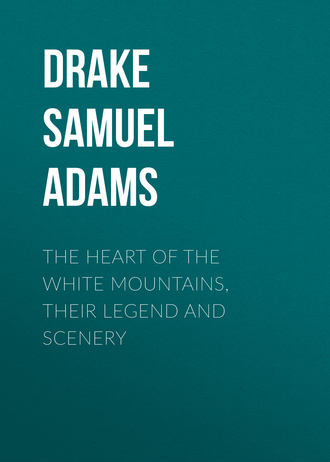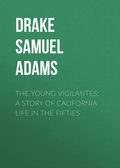
Drake Samuel Adams
The Heart of the White Mountains, Their Legend and Scenery
IV.
FRANCONIA, AND THE NEIGHBORHOOD
Believe if thou wilt that mountains change their places, but believe not that men change their dispositions. —Oriental Proverb.
ALTHOUGH one may make the journey from the Profile House to Bethlehem with greater ease and rapidity by the railway recently constructed along the side of the Franconia range, preference will unquestionably be given to the old way by all who would not lose some of the most striking views the neighborhood affords. Beginning near the hotel, the railway skirts the shore of Echo Lake, and then plunges into a forest it was the first to invade. By a descent of one hundred feet to the mile, for nine and a half miles, it reaches the Ammonoosuc at Bethlehem station. I have nothing to say against the locomotive, but then I should not like to go through the gallery of the Louvre behind one.
From Echo Lake the high-road to Franconia, Littleton, and Bethlehem winds down the steep mountain side into the valley of Gale River. To the left, in the middle distance, appear the little church-tower and white buildings constituting the village of Franconia Iron Works. This village is charmingly placed for effectively commanding a survey of the amphitheatre of mountains which isolates it from the neighboring towns and settlements.
As we come down the three-mile descent, from the summit of the pass to the level of the deep valley, and to the northern base of the notch-mountains, an eminence rises to the left. Half-way up, occupying a well-chosen site, there is a hotel, and on the high ridge another commands not only this valley, but also those lying to the west of it. On the opposite side to us rise the green heights of Bethlehem, Mount Agassiz being conspicuous by the observatory on its summit. Those farm-houses dotting the hill-side show how the road crooks and turns to get to the top. Following these heights westward, a deep rift indicates the course of the stream dividing the valley, and of the highway to Littleton. Between these walls the long ellipse of fertile land beckons us to descend.
I am always most partial to those grassy lanes and by-ways going no one knows where, especially if they have well-sweeps and elm-trees in them; but here also is the old red farm-house, with its antiquated sweep, its colony of arching elms, its wild-rose clustering above the porch, its embodiment of those magical words, “Home, sweet home.” It fits the rugged landscape as no other habitation can. It fits it to a T, as we say in New England. More than this, it unites us with another and different generation. What a story of toil, privation, endurance these old walls could tell! How genuine the surprise with which they look down upon the more modern houses of the village! Here, too, is the Virginia fence, on which the king of the barn-yard defiantly perches. There is the field behind it, and the men scattering seed in the fallow earth. Yonder, in the mowing-ground, a laborer is sharpening his scythe, the steel ringing musically under the quick strokes of his “rifle.”
Over there, to the left, is the rustic bridge, and hard by a clump of peeled birches throw their grateful shade over the hot road. Many stop here, for the white-columned trunks are carved with initials, some freshly cut, some mere scars. But why mutilate the tree? What signify those letters, that every idler should gratify his little vanity by giving it a stab? Do you know that the birch does not renew its bark, and that the tree thus stripped of its natural protection is doomed? Cease, then, I pray you, this senseless mutilation; nor call down the just malediction of the future traveller for destroying his shade. Unable to escape its fate, the poor tree, like a victim at the stake, stoically receives your barbarous strokes and gashes. Refrain, then, traveller, for pity’s sake! Have a little mercy! Know that the ancients believed the tree possessed of a soul. Remember the touching story of Adonis, barbarously wounded, surviving in a pine, where he weeps eternally. Consider how often is the figure of “The Tree” used in the Scriptures as emblematic of the life eternal! Who would wish to inhabit a treeless heaven?
The stream – which does not allow us to forget that it is here – is a vociferous mountain brook. Hardly less forward is the roadside fountain gushing into a water-trough its refreshing abundance for the tired and dusty wayfarer. It makes no difference in the world whether he goes on two legs or on four. “Drink and be filled” is the invitation thus generously held out to all alike. With what a sigh of pleasure your steaming beast lifts his reluctant and dripping muzzle from the cool wave, and after satisfying again and again his thirst, luxuriously immersing his nose for the third and fourth time, still pretends to drink! How deliciously light and limpid and sparkling is the water, and how sweet! How it cools the hot blood! You quaff nectar. You sip it as you would champagne. It tastes far better, you think, pouring from this half-decayed, moss-crusted spout than from iron, or bronze, or marble. Come, fellow-traveller, a bumper! Fill high! God bless the man who first invented the roadside fountain! He was a true benefactor of his fellow-man.
Turn once more to the house. A little girl tosses corn, kernel by kernel, to her pet chickens. There go a flight of pigeons: they curvet and wheel, and settle on the ridge-pole, where they begin to flirt, and strut, and coo. The men in the field look up at the top of the mountain, to see if it is not yet noon. And now a woman, with plump bare arms, coming briskly to the open door, puts the dinner-horn to her lips with one hand while placing the other lightly upon her hip. She does not know that act and attitude are alike inviting. How should she?
Let us follow the pretty stream that is our guide. Franconia has the reputation of being the hottest in summer and in winter the coldest of the mountain villages. It is hot. The houses are strung along the road for a mile. People may or may not live in them: you see nobody. One modest church-tower catches the eye for a moment, and then, as we enter the heart of the village, a square barrack of a building, just across the stream, is pointed out as the old furnace, which in times past gave importance to this out-of-the-way corner. But the old furnace is now deserted except by cows from the neighboring pastures, who come and go through its open doors in search of shade. At present the river, which brings its music and its freshness to the very doors of the villagers, is the only busy thing in the place.
During the Rebellion the furnace was kept busy night and day, turning out iron to be cast into cannon. The very hills were melted down for the defence of the imperilled Union. In the adjoining town of Lisbon the discovery of gold-bearing quartz turned the heads of the usually steady-going population. The precious deposits were first found on the Bailey farm, in 1865, and similar specimens were soon detected on the farms adjoining. It is said the old people could scarcely be made to credit these reports until they had seen and handled the precious metal; for the country had been settled nearly a century, and the presence of any but the baser ores was wholly unsuspected and disbelieved.
There is one peculiarity, common to all these mountain villages, to which I must allude. A stranger is not known by any personal peculiarity, but by his horse. If you ask for such or such a person, the chances are ten to one you will immediately be asked in return if he drove a bay horse, or a black colt, or a brown mare with one white ear; so quick are these lazy-looking men, that loll on the door-steps or spread themselves out over the shop-counters, to observe what interests them most. The girls here know the points of a horse better than most men, and are far more reckless drivers than men. To a man who, like myself, has lived in a horse-stealing country, it does look queerly to see the barn-doors standing open at night. But then every country has its own customs.
One seeks in vain for any scraps of history or tradition that might shed even a momentary lustre upon this village out of the past. Yet its situation invites the belief that it is full of both. Disappointed in this, we at least have an inexhaustible theme in the dark and tranquil mountains bending over us.
Mount Lafayette presents toward Franconia two enormous green billows, rolled apart, the deep hollow between being the great ravine dividing the mountain from base to summit. Over this deep incision, which, from the irregularity of one of its ridges, looks widest at the top, presides, with matchless dignity, the bared and craggy peak whose dusky brown gradually mingles with the scant verdure checked hundreds of feet down. With what hauteur it seems to regard this effort of Nature to place a garland on its bronzed and knotted forehead! One can never get over his admiration for the savage grace with which the mountain, which at first sight seems literally thrown together, develops a beauty, a harmony, and an intelligence giving such absolute superiority to works of Nature over those of man.
The side of Mount Cannon turned toward the village now elevates two almost regular triangular masses, one rising behind the other, and both surmounted by the rounded summit, which, except in its mass, has little resemblance to a mountain. It is seen that on two-thirds of these elevations a new forest has replaced the original growth. Twenty-five years ago a destructive fire raged on this mountain, destroying all the vegetation, as well as the thin soil down to the hard rock. Even that was cracked and peeled like old parchment. This burning mountain was a scene of startling magnificence during several nights, when the village was as light as day, the sky overspread an angry glow, and the river ran blood-red. The hump-backed ridges, connecting Cannon with Kinsman, present nearly the same appearance from this as from the other side of the Notch – or as remarked when approaching from Campton.
The superb picture seen from the upper end of the valley, combining, as it does, the two great chains in a single glance of the eye, is extended and improved by going a mile out of the village to the school-house on the Sugar Hill road. It is a peerless landscape. I have gazed at it for hours with that ineffable delight which baffles all power of expression. It will have no partakers. One must go there alone and see the setting sun paint those vast shapes with colors the heavens alone are capable of producing.
Distinguished by the beautiful groves of maple that adorn its crest, Sugar Hill is destined to grow more and more in the popular esteem. No traveller should pass it by. It is so admirably placed as to command in one magnificent sweep of the eye all the highest mountains; it is also lifted into sun and air by an elevation sufficiently high to reach the cooler upper currents. The days are not so breathless or so stifling as they are down in the valley. You look deep into the Franconia Notch, and watch the evening shadows creep up the great east wall. Extending beyond these nearer mountains, the scarcely inferior Twin summits pose themselves like gigantic athletes. Passing to the other side of the valley, we see as far as the pale peaks of Vermont, and those rising above the valley of Israel’s River. But better than all, grander than all, is that kingly coronet of great mountains set on the lustrous green cushion of the valley. Nowhere, I venture to affirm, will the felicity of the title, “Crown of New England,”32 receive more unanimous acceptance than from this favored spot. Especially when a canopy of clouds overspreading permits the pointed peaks to reflect the illuminated fires of sunset does the crown seem blazing with jewels and precious stones. All the great summits are visible here, and all the ravines, except those in Madison, are as clearly distinguished as if not more than ten instead of twenty miles separated us.
The high crest of Sugar Hill unfolds an unrivalled panorama. This is but faint praise. Yet I find myself instinctively preferring the landscape from Goodenow’s; for those great horizons, uncovered all at once, like a magnificent banquet, are too much for one pair of eyes, however good, or however unwearied with continued sight-seeing. As we cannot look at all the pictures of a gallery at once, we naturally single out the masterpieces. The effort to digest too much natural scenery is a species of intellectual gluttony the overtaxed brain will be quick to revenge, by an attack of indigestion or a loss of appetite.
I was very fond of walking, in the cool of the evening, either in this direction or to the upper end of the village, on the Bethlehem road. There is one point on this road, before it begins in earnest its ascent of the heights, that became a favorite haunt of mine. Emerging from the concealment of thick woods upon a sandy plain, covered here with a thick carpet of verdure, and skirted by a regiment of pines seemingly awaiting only the word of command to advance into the valley, a landscape second to none that I have seen is before you. At the same time he would be an audacious mortal who attempted to transfer it to page or canvas. Nothing disturbs the exquisite harmony of the scene. To the left of you are all the White Mountains, from Adams to Pleasant; in front, the Franconia range, from Kinsman to the Great Haystack. Here is the deep rent of the Notch from which we have but lately descended. Here, too, overtopped and subjugated by the superb spire of Lafayette, the long and curiously-distorted outline of Eagle Cliff pitches headlong down into the half-open aperture of the pass. Nothing but an earthquake could have made such a breach. How that tremendous, earth-swooping ridge seems battered down by the blows of a huge mace! Unspeakably wild and stern, the fractured mountains are to the valley what a raging tempest is to the serenest of skies: one part of the heavens convulsed by the storm, another all peace and calm. Thus from behind his impregnable outworks Lafayette, stern and defiant, keeps eternal watch and ward over the valley cowering at his feet.
From this spot, too, sacred as yet from all intrusion, the profound ravine, descending nearly from the summit of Lafayette, is fully exposed. It is a thing of cracks, crevices, and rents; of upward curves in brilliant light; of black, mysterious hollows, which the eye investigates inch by inch, to where the gorge is swallowed up by the thick forests underneath. The whole side of the principal peak seems torn away. Up there, among the snows, is the source of a flashing stream which comes roaring down through the gorge. Storms swell it into an ungovernable and raging torrent. Thus under the folds of his mantle the lordly peak carries peace or war for the vale.
After the half-stifled feeling experienced among the great mountains, it is indeed a rare pleasure to once more come forth into full breathing-space, and to inspect at leisure from some friendly shade the grandeur magnified by distance, yet divested of excitements that set the brain whirling by the rapidity of their succession. If the wayfarer chances to see, as I did, the whole noble array of high summits presenting a long, snowy line of unsullied brilliance against a background of pale azure, he will account it one of the crowning enjoyments of his journey.
The Bridal Veil Falls, lying on the northern slope of Mount Kinsman, will, when a good path shall enable tourists to visit them, prove one of the most attractive features of Franconia. Truth compels me to say that I did not once hear them spoken of during the fortnight passed in the village, although fishermen were continually bringing in trout from the Copper-mine Brook, on which these falls are situated. The height of the fall is given at seventy-six feet, and its surroundings are said to be of the most romantic and picturesque character. Its marvellous transparency, which permits the ledges to be seen through the gauze-like sheet falling over them, has given to it its name.
From Franconia I took the daily stage to Littleton, which lies on both banks of the Ammonoosuc, and, turning my back upon the high mountains, ran down the rail to Wells River, having the intention of cultivating a more intimate acquaintance with that most noble and interesting entrance formed by the meeting of the Ammonoosuc with the Connecticut.
V.
THE CONNECTICUT OX-BOW
Say, have the solid rocks
Into streams of silver been melted,
Flowing over the plains,
Spreading to lakes in the fields?
Longfellow.
THE Connecticut is justly named “the beautiful river,” and its valley “the garden of New England.” Issuing from the heart of the northern wilderness, it spreads boundless fertility throughout its stately march to the sea. It is not a rapid river, but flows with an even and majestic tide through its long avenue of mountains. Radiant envoy of the skies, its mission is peace on earth and good-will toward men. As it advances the confluent streams flock to it from their mountain homes. On one side the Green Mountains of Vermont send their hundred tributaries to swell its flood; on the other side the White Hills of New Hampshire pour their impetuous torrents into its broad and placid bosom. Two States thus vie with each other in contributing the wealth it lavishes with absolutely impartial hand along the shores of each.
Unlike the storied Rhine, no crumbling ruins crown the lofty heights of this beautiful river. Its verdant hill-sides everywhere display the evidences of thrift and happiness; its only fortresses are the watchful and everlasting peaks that catch the earliest beams of the New England sun and flash the welcome signal from tower to tower. From time to time the mountains, which seem crowding its banks to see it pass, draw back, as if to give the noble river room. It rewards this benevolence with a garden-spot. Sometimes the mountains press too closely upon it, and the offended stream repays this temerity with a barrenness equal to the beneficence it has just bestowed. Where it is permitted to expand the amphitheatres thus created are the highest types of decorative nature. Graciously touching first one shore and then the other, making the loveliest windings imaginable, the river actually seems on the point of retracing its steps; but, yielding to destiny, it again resumes its slow march, loitering meanwhile in the cool shadows of the mountains, or indolently stretching itself at full length upon the green carpet of the level meadows. Every traveller who has passed here has seen the Happy Valley of Rasselas.33
Such is the renowned Ox-Bow of Lower Coös. Tell me, you who have seen it, if the sight has not caused a ripple of pleasurable excitement?
Here the Connecticut receives the waters of the Ammonoosuc, flowing from the very summit of the White Hills, and, in its turn, made to guide the railway to its own birthplace among the snows of Mount Washington. Here the valley, graven in long lines by the ploughshare, heaped with fruitful orchards and groves, extends for many miles up and down its checkered and variegated floor. But it is most beautiful between the villages of Newbury and Haverhill, or at the Great and Little Ox-Bow, where the fat and fecund meadows, extending for two miles from side to side of the valley, resemble an Eden upon earth, and the villages, prettily arranged on terraces above them, half-hid in a thick fringe of foliage, the mantel-ornaments of their own best rooms. Only moderate elevations rise on the Vermont side; but the New Hampshire shore is upheaved into the finely accentuated Benton peaks, behind which, like a citadel within its outworks, is uplifted the gigantic bulk of Moosehillock – the greatest mountain of all this valley, and its natural landmark – keeping strict watch over it as far as the Canadian frontiers.
The traveller approaching by the Connecticut Valley holds this exquisite landscape in view from the Vermont side of the river. The tourist who approaches by the valley of the Merrimac enjoys it from the New Hampshire shore.
The large village of Newbury, usually known as the “Street,” is built along a plateau, rising well above the intervale, and joined to the foothills of the Green Mountains. The Passumpsic Railway coasts the intervale, just touching the northern skirt of the village. The village of Haverhill is similarly situated with respect to the skirt of the White Mountains; but its surface is much more uneven, and it is elevated higher above the valley than its opposite neighbor. The Boston, Concord, and Montreal Railway, having crossed the divide between the waters of the Merrimac and the Connecticut, now follows the high level, after a swift descent from Warren Summit. These plateaus, or terraces, forming broken shelves, first upon one side of the valley, then upon the other, strongly resemble the remains of the ancient bed of a river of tenfold the magnitude of the stream as we see it to-day. They give rise at once to all those interesting conjectures, or theories, which are considered the special field of the geologist, but are also equally attractive to every intelligent observer of Nature and her wondrous works.
Of these two villages, which are really subdivided into half a dozen, and which so beautifully decorate the mountain walls of this valley, it is no treason to the Granite State to say that Newbury enjoys a preference few will be found to dispute. It has the grandest mountain landscape. Moosehillock is lifted high above the Benton range, which occupies the foreground. The whole background is filled with high summits – Lafayette feeling his way up among the clouds, Moosehillock roughly pushing his out of the throng. Meadows of emerald, river of burnished steel, hill-sides in green and buff, and etched with glittering hamlets, gray mountains, bending darkly over, cloud-detaining peaks, vanishing in the far east – surely fairer landscape never brought a glow of pleasure to the cheek, or kindled the eye of a traveller, already sated with a panorama reaching from these mountains to the Sound.
We are now, I imagine, sufficiently instructed in the general characteristics of the famed Ox-Bow to pass from its picturesque and topographical features into the domain of history, and to summon from the past the details of a tragedy in war, which, had it occurred in the days of Homer, would have been embalmed in an epic. Our history begins at a period before any white settlement existed in the region immediately about us. No wonder the red man relinquished it only at the point of the bayonet. It was a country worth fighting for to the bitter end.






